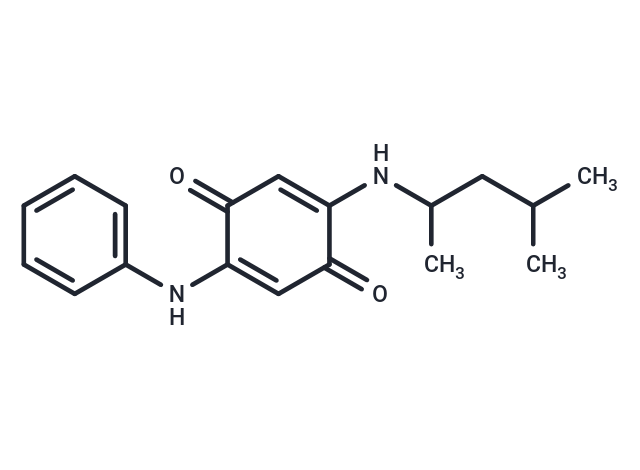 Your shopping cart is currently empty
Your shopping cart is currently empty

6PPD-Q (6PPD-Quinone) is an environmental pollutant that can target CNR2, CNR1, AA2AR, LCAT and TRPA1. Among them, CNR2 has the highest binding affinity and may act as a CNR2 receptor agonist to activate cannabinoid receptors. 6PPD-Q can damage the sperm quality and induce the impairment of male reproductive ability in mice. 6PPD-Q can induce intestinal inflammation and barrier damage by disrupting mitochondrial function, reducing neuronal glycolytic metabolites and TCA cycle intermediates, and exacerbating α-synuclein (α-syn) aggregation.

| Pack Size | Price | USA Warehouse | Global Warehouse | Quantity |
|---|---|---|---|---|
| 1 mg | $55 | In Stock | In Stock | |
| 5 mg | $125 | In Stock | In Stock | |
| 10 mg | $183 | In Stock | In Stock | |
| 25 mg | $297 | In Stock | In Stock | |
| 50 mg | $453 | In Stock | - |
| Description | 6PPD-Q (6PPD-Quinone) is an environmental pollutant that can target CNR2, CNR1, AA2AR, LCAT and TRPA1. Among them, CNR2 has the highest binding affinity and may act as a CNR2 receptor agonist to activate cannabinoid receptors. 6PPD-Q can damage the sperm quality and induce the impairment of male reproductive ability in mice. 6PPD-Q can induce intestinal inflammation and barrier damage by disrupting mitochondrial function, reducing neuronal glycolytic metabolites and TCA cycle intermediates, and exacerbating α-synuclein (α-syn) aggregation. |
| Targets&IC50 | HEK293 cells (40 g/L HSA):23.96 μM, HEK293 cells (10% FBS):11.78 μM, ERRγ:6 nM, L02 cells:22.51 µg/L, HEK293 cells (Albumin-free):3.84 μM |
| In vitro | METHODS: Mouse dopaminergic neurons were treated with 6PPD-Q (10 nM, 100 nM) for 48 hours to detect cell growth inhibition. RESULTS: R6PPD-Q did not exhibit significant cytotoxicity. [1] METHODS: Mouse dopaminergic neurons were treated with 6PPD-Q (10 nM, 100 nM) for 7 days, and target protein expression was detected by Western Blot. RESULTS: R6PPD-Q significantly increased Triton X-100-insoluble α-synuclein (α-syn) protein levels. [1] |
| In vivo | METHODS: To study the effect of 6PPD-Q on intestinal injury, 6PPD-Q (0.1, 1, 10, 100 μg/kg) was orally administered to ICR mice once daily for 21 days. RESULTS: 6PPD-Q caused intestinal injury in ICR mice, which was manifested as enhanced inflammatory response in jejunum and ileum and impaired intestinal barrier integrity. [2] |
| Synonyms | 6PPD-Quinone |
| Molecular Weight | 298.38 |
| Formula | C18H22N2O2 |
| Cas No. | 2754428-18-5 |
| Smiles | O=C1C=C(NC(C)CC(C)C)C(=O)C=C1NC=2C=CC=CC2 |
| Color | Red |
| Appearance | Solid |
| Storage | keep away from direct sunlight,keep away from moisture | Powder: -20°C for 3 years | In solvent: -80°C for 1 year | Shipping with blue ice/Shipping at ambient temperature. | |||||||||||||||||||||||||
| Solubility Information | DMSO: 10 mg/mL (33.51 mM), Sonication and heating are recommended. H2O: < 1 mg/mL (insoluble or slightly soluble) | |||||||||||||||||||||||||
Solution Preparation Table | ||||||||||||||||||||||||||
DMSO
| ||||||||||||||||||||||||||
| Size | Quantity | Unit Price | Amount | Operation |
|---|

Copyright © 2015-2025 TargetMol Chemicals Inc. All Rights Reserved.